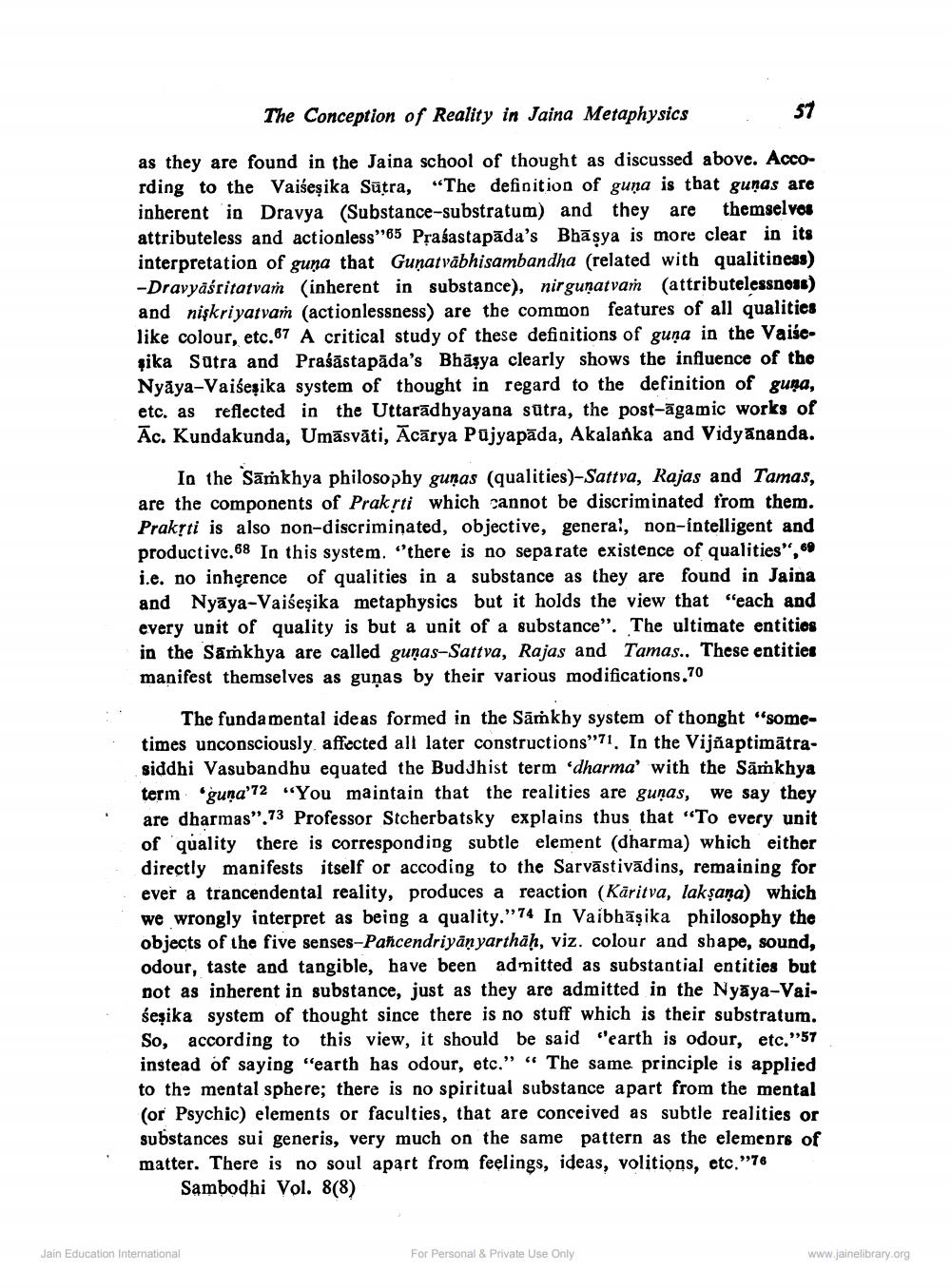________________
The Conception of Reality in Jaina Metaphysics
57
as they are found in the Jaina school of thought as discussed above. According to the Vaišeşika Sūtra, "The definition of guna is that gunas are inherent in Dravya (Substance-substratum) and they are themselves attributeless and actionless"65 Prasastapāda's Bhāsya is more clear in its interpretation of guna that Gunatvábhisambandha (related with qualitiness) -Dravyäśritatvam (inherent in substance), nirgunatvam (attributelessnou) and niskri yatvaṁ (actionlessness) are the common features of all qualities like colour, etc. 67 A critical study of these definitions of guna in the Vaiseșika Sutra and Praśāstapāda's Bhāşya clearly shows the influence of tho Nyāya-Vaiseșika system of thought in regard to the definition of guņa, etc. as reflected in the Uttarādhyayana sutra, the post-āgamic works of Ac. Kundakunda, Umāsvāti, Ācārya Pujyapāda, Akalanka and Vidyānanda.
In the Sāṁkhya philosophy gunas (qualities)-Sattva, Rajas and Tamas, are the components of Prakrti which cannot be discriminated from them. Praksti is also non-discriminated, objective, general, non-intelligent and productive.68 In this system. there is no separate existence of qualities", 69 i.e. no inherence of qualities in a substance as they are found in Jaina and Nyāya-Vaiseșika metaphysics but it holds the view that "each and every unit of quality is but a unit of a substance". The ultimate entities in the Samkhya are called guņas-Sattva, Rajas and Tamas.. These entities manifest themselves as guņas by their various modifications.70
The fundamental ideas formed in the Sāṁkhy system of thonght "sometimes unconsciously affected all later constructions"71. In the Vijñaptimātrasiddhi Vasubandhu equated the BudJhist term 'dharma' with the Sāṁkhya term 'guna'72 “You maintain that the realities are guņas, we say they are dharmas”.73 Professor Stcherbatsky explains thus that “To every unit of quality there is corresponding subtle element (dharma) which either directly manifests itself or accoding to the Sarvāstivādins, remaining for ever a trancendental reality, produces a reaction (Käritva, laksana) which we wrongly interpret as being a quality.”74 In Vaibhāṣika philosophy the objects of the five senses-Pañcendriyāṇyarthāḥ, viz. colour and shape, sound, odour, taste and tangible, have been admitted as substantial entities but not as inherent in substance, just as they are admitted in the Nyāya-Vaiśeşika system of thought since there is no stuff which is their substratum. So, according to this view, it should be said "earth is odour, etc."57 instead of saying "earth has odour, etc." “ The same principle is applied to the mental sphere; there is no spiritual substance apart from the mental (or Psychic) elements or faculties, that are conceived as subtle realities or substances sui generis, very much on the same pattern as the elemenrs of matter. There is no soul apart from feelings, ideas, volitions, etc.”76
Sambodhi Vol. 8(8)
Jain Education International
For Personal & Private Use Only
www.jainelibrary.org




